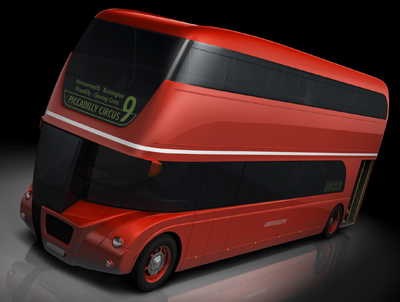
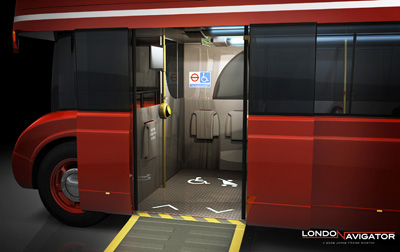
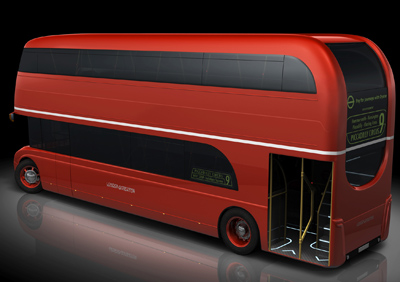
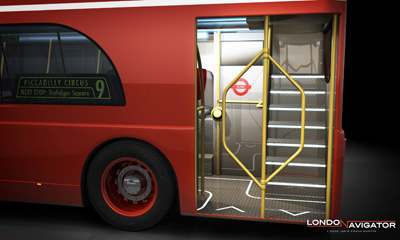
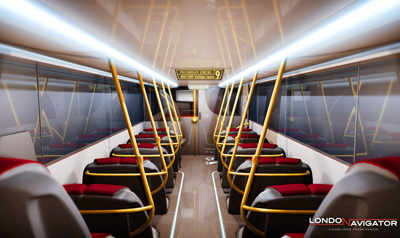
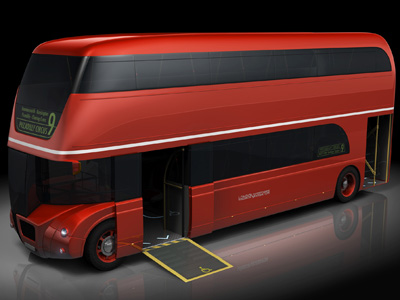
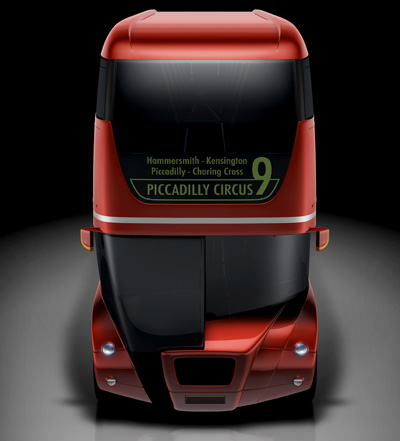
All
images courtesy and © of Jamie Martin
|
|
| Make
|
- |
| Model |
London
Navigator |
| Concept
year |
2009 |
| Production
year |
- |
| Engine |
Hybrid |
The London Navigator is a concept which was created as
a spiritual successor to the now classic Routemaster bus
which was retired in 2004. The London Navigator concept
by Jamie Martin won second place in a competition which
asked designers to come up with a replacement vehicle
for London's bus service. Elements of the winning designs
will be used to influence the look of the new London bus,
due for release in 2011.
The original Routemaster bus was regarded as one of the
most recognizable icons in London. It was felt that an
equally distinctive replacement was required to retain
this status; a red bus that can only be associated with
London, is easily distinguishable from the standard double-decker
or bendy bus, and is quintessentially British.
The London Navigator features an open access platform
at the rear near-side corner, plus an automatic double-door
located immediately behind the near-side front wheel.
The interior design provides for the needs of a second
crew member, and incorporates a conductor-only foldable
seat at the front entrance, for use when required. Total
capacity for the London Navigator (including 16 standing
passengers) is 88, or 86 when carrying a wheelchair user.
The London Navigator bus consists of a lightweight monocoque
aluminium chassis, covered by a combination of bonded
and riveted aluminium and fibreglass bodywork.
The London Navigator concept has been designed to accommodate
a variety of drivetrains. The initial proposal is for
a hybrid vehicle which uses a 4.8-litre engine running
off biodiesel, powering the rear wheels via in-wheel electric
motors. Because the electric motors don't require a transmission
to receive power from the engine the London Navigator
benefits from a low-floor layout which increases passenger
space.
By using regenerative braking the in-wheel motors are
able to return power to the lithium-ion batteries located
alongside the rear wheels and under the rear stairwell
(where the bio-diesel tank and A/C unit are also housed).
Such technology could provide a 30 - 40 percent lower
fuel consumption over similar diesel powered buses.
One of the most prominent exterior features of the London
Navigator bus concept are the large electronic displays
which feature at both the front and rear ends of the vehicle.
These show the bus number and route information. The rear
display additionally incorporates a designated section
that can be used for animated or scrolling advertisements.
Further information is provided to the passengers on displays
showing bus number, main destination, and next stop situated
at the side of the bus, beside the rear open platform.
Two similar ceiling-mounted displays are also fitted on
each of the two floors of the bus.
The driver of the London Navigator is seated in his own
'cocoon'; a cab accessed through a reinforced, lockable
door from the main body of the bus. The dashboard includes
multi-function screens for monitoring CCTV and external
cameras, air conditioning, and a communication link with
the main control center via radio and computer assisted
information monitor. Due to the split front-end design
of the bus, and the raised seating position, the driver
is provided with a wide field of vision.
Similar and related vehicles:
 Cobra Venom V8 by Jamie Martin
Cobra Venom V8 by Jamie Martin
|
|

